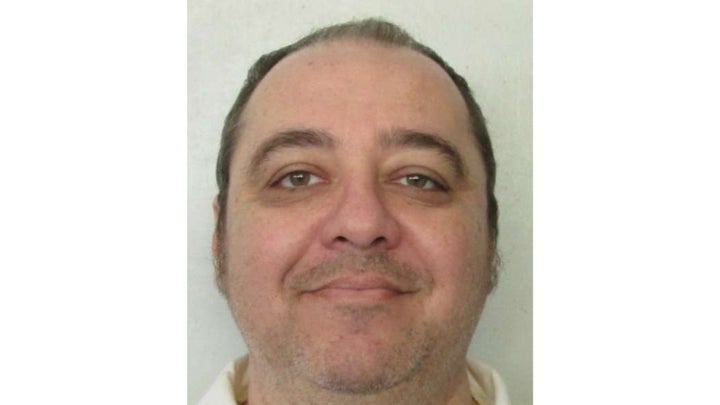In 1996, a jury recommended 11-1 that Kenneth Smith be sentenced to life without the possibility of parole for his role in a murder-for-hire plot. The judge overruled the jury and imposed a death sentence, a practice that is no longer legal. Now, nearly three decades later, the state of Alabama plans to use Smith as a test subject for a new execution method: death by inhaling nitrogen gas.
The state’s decision to execute Smith by nitrogen hypoxia on Thursday — forcing him to breathe only nitrogen through a mask while depriving him of oxygen — comes after a failed attempt to kill him by lethal injection in November 2022. Although Alabama is one of three states that has authorized executions using nitrogen gas, no state or the federal government has actually carried out such an execution.
Alabama switched its planned killing method in Smith’s case after he fought in court to block the state from attempting to kill him again through lethal injection. In addition to Smith, Alabama has failed to kill two other people it tried to execute with lethal injection in recent years. In a fourth lethal injection execution, the killing took more than three hours. Even in lethal injection executions with no observable problems, autopsies of the deceased show signs of pulmonary edema, a condition where the lungs fill with fluid and create the painful sensation of suffocating or drowning.
Despite the clear problems with lethal injection executions, there is no evidence that executions using nitrogen would be any more humane. A botched nitrogen execution could lead to a slow, painful death by asphyxiation — or even leave the individual alive but in a persistent vegetative state, according to medical experts. Alabama’s plan to supply nitrogen through a mask worn by Smith also poses a risk to others in the execution chamber, including Smith’s spiritual adviser, Rev. Jeff Hood.
“This is the most inept, unqualified, unprofessional execution squad in the country. And they think they’re going to be the ones to do this nitrogen hypoxia without a hitch?” Hood said in an interview. “Kenny is facing a torture of uncertainty throughout all of this. I think it is as cruel and unusual as any punishment in human history.”
Smith, who along with his lawyers did not respond to a request for comment, previously told NPR that he is “terrified” by the prospect of being killed with nitrogen gas.
“I’ve been doing time for 35 years now, and I’ve tried to place myself in my brothers’ shoes when they’re around the corner and going through this. But nothing prepares you for it,” Smith said. “The anxiety and stuff starts building up before you ever get your date. And now that you’re approaching that time, the anxiety starts to build. And, yeah, there is a mental trauma there that I never realized until I went through that.”

Had Smith’s trial taken place today, he would not have received a death sentence. In 2017, Alabama became the last state to ban judges from overriding jury recommendations to impose death sentences. However, like many criminal justice reforms, the change was not applied retroactively and Smith remained on death row.
Alabama authorized nitrogen hypoxia as a method of execution in 2018, amid a shortage of lethal injection drugs and a lawsuit by people on death row challenging the constitutionality of the state’s lethal injection procedure.
Weeks before Gov. Kay Ivey (R) signed the legislation allowing nitrogen gas executions, the state unsuccessfully attempted to execute a terminally ill man named Doyle Lee Hamm, whose veins had deteriorated from drug use and treatment for cancer and hepatitis C. Executioners punctured him at least 11 times in his legs, ankles and groin, only stopping when the death warrant was close to expiring. Hamm experienced extensive bruising, a large amount of blood loss near his groin, and later reported blood in his urine. The state agreed not to try to execute him again and he died in 2021.
But Alabama continued botching lethal injection executions. In July 2022, the state took more than three hours to kill Joe Nathan James Jr., making it the longest lethal injection execution in the U.S. Although Alabama Department of Corrections Commissioner John Hamm said “nothing out of the ordinary” had occurred, the autopsy suggested otherwise. Failed attempts to insert IV catheters left puncture wounds and bruising on James’ hands, wrists and arms, in addition to unexplained incisions.
The autopsy indicated that the people responsible for inserting the IV were “unqualified for the task in the most dramatic way,” Joel Zivot, an associate professor of anesthesiology who advocates against using tools of medicine for the death penalty, told The Atlantic. (The American Medical Association states in its code of medical ethics that as members of a profession dedicated to preserving life, physicians must not participate in executions.)
Two months later, Alabama unsuccessfully tried to execute Alan Eugene Miller. Again, execution officials failed to set IV lines after repeatedly puncturing him with needles for approximately 90 minutes. By the end of the night, Miller “was suspended vertically from a cross-shaped table, hands and one foot bleeding in an execution chamber and the state of Alabama apparently realizing it wouldn’t be able to kill him within the time it had,” journalist Elizabeth Bruenig, who observed Miller’s execution, wrote in the Atlantic.
Smith was aware of these botched executions as his first execution date approached. There was no indication that Alabama’s prison system had paused to investigate its failures in the cases of Hamm, James and Miller before leading Smith into the execution chamber on Nov. 17, 2022. There, he lay strapped to the gurney, unable to move for nearly four hours. Unbeknownst to him, a federal appellate court had stayed his execution. Rather than release him from the gurney, prison officials left him there until the Supreme Court vacated the stay.
Once Smith’s appeals were exhausted, the jabbing began. First, execution officials tried to set two IV lines, sliding a needle in and out of his arms and hands, ignoring him as he said they were penetrating his muscles and causing him severe pain, his lawyers wrote in a complaint filed in federal court in November. When that failed, the IV team tilted the gurney backward until Smith was in a “reverse crucifixion position with his head below his feet,” the complaint stated. A member of the IV team made five or six jabs with a clear syringe in his collarbone area before inserting a large-gauge needle into his collarbone and jabbing him several more times. It was so painful that Smith constricted against the gurney restraints, injuring his shoulder. He struggled to breathe.
“They were just sticking me over and over, going in the same hole like a freaking sewing machine,” Smith told NPR. “I was absolutely alone in a room full of people, and not one of them tried to help me at all — and I was crying out for help.”
When the execution team finally called off the killing shortly before midnight, Smith was unable to stand, walk or dress himself without assistance, the complaint said. He still experiences severe post-traumatic stress disorder symptoms, including nightmares, hypervigilance, hyperarousal and dissociation.
Smith and Miller are the only two people alive who have survived an execution procedure in the country.
“They were just sticking me over and over, going in the same hole like a freaking sewing machine.”
- Kenneth Smith
Ahead of his first execution date, Smith sued the Alabama Department of Corrections Commissioner, alleging that the state’s lethal injection protocol violated Eighth Amendment protections against cruel and unusual punishment. The Supreme Court has previously held that prisoners challenging the legality of an execution method must identify an alternative method that is feasible, readily implemented and reduces the risk of severe pain.
Smith identified nitrogen hypoxia as an alternative method but the corrections department repeatedly took the position that it was not an “available” alternative. “Then, on the eve of being required to disclose information regarding its failed attempt to execute Mr. Smith by lethal injection, [Alabama Department of Corrections] suddenly changed course, now claiming it is prepared to carry out executions using nitrogen hypoxia,” Smith’s lawyers wrote in the complaint filed last November.
The corrections department filed its nitrogen hypoxia protocol last August as part of a motion to dismiss Smith’s previous lawsuit. The protocol was so heavily redacted it was “impossible to determine with specificity how the lethal gas process will proceed,” Robert Dunham, the director of the Death Penalty Policy Project, wrote at the time.
When Smith proposed nitrogen hypoxia as an alternative to lethal injection, his lawyers wrote, “he did not agree to be executed without knowing the protocol, much less by ADOC using a heavily redacted protocol that he had never seen and that was hastily introduced as a means to moot Mr. Smith’s pending litigation about ADOC’s previous failed attempt to execute him by lethal injection and forestall discovery into it.”
Based on the readable text of the nitrogen hypoxia protocol, Smith is at risk of experiencing an excruciating death — or of surviving but suffering other medical issues, his lawyers said. The use of a one-size-fits-all mask to deliver the nitrogen risks having an inadequate seal. If oxygen leaks into the mask, Smith could experience a prolonged, painful death, or even experience a stroke or a persistent vegetative state, the lawyers wrote.
The protocol does not specify the purity of the nitrogen or how it will be stored to prevent contamination, Smith’s lawyers noted. Airgas, a major gas distributor for Alabama, has previously stated it would not supply the state with gas to use in executions, echoing moves by drug manufacturers who refused to provide drugs for lethal injection executions.
Earlier this month, U.S. District Judge R. Austin Huffaker Jr. allowed Alabama to move forward with executing Smith with nitrogen, ruling that Smith had not sufficiently proven the process was likely to cause a prolonged, painful death. Huffaker said in his ruling that Smith has been given an unredacted copy of the state’s nitrogen execution protocol.
Smith is appealing the ruling.
Huffaker’s ruling has created a situation in which the standards for euthanizing animals are more restrictive than the standards for killing healthy humans. The American Veterinary Medical Association said in its 2020 euthanasia guidelines that although nitrogen exposure may be an acceptable way to kill chickens, turkeys or pigs under certain conditions, it should not be used to kill other mammals. Rats who were exposed to high nitrogen gas levels showed signs of “panic and distress” before dying, the AVMA said.
Hood, Smith’s spiritual adviser, plans to be in the execution chamber with Smith to deliver his last rites. He was required to sign a waiver acknowledging the risk that he could inadvertently be exposed to the odorless, tasteless nitrogen gas.
Hood, who has witnessed several lethal injection executions as a spiritual adviser to people on death row, said it is important to him that the people he works with are not alone in their final moments.
“I want my guys to always know that what is happening to them is evil. It’s not right.”

